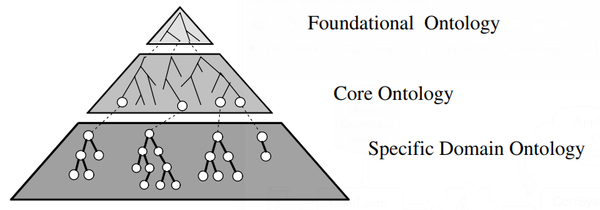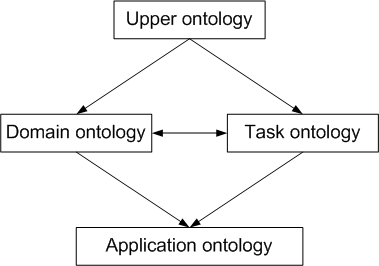Domain-Specific Ontology
A Domain-Specific Ontology is an ontology that is a domain-specific KB.
- AKA: Situated Ontology, Formal Machine-Readable Domain KB.
- Context:
- It can be used by a Knowledge-based Solution.
- It can (typically) be incomplete because of the Knowledge Acquisition Bottleneck.
- It can range from being a Lightweight Domain Specific Ontology to being a Heavyweight Domain Specific Ontology.
- It can range from being a Small Domain-Specific Ontology to being a Medium-Sized Domain-Specific Ontology to being a Large Domain-Specific Ontology.
- …
- Example(s):
- Scientific Domain Ontologies, such as:
- a Bibliographic Ontology, such as Dublin Core Ontology.
- a Biological Ontology, such as GO gene ontology.
- a Data Mining Ontology, such as kddo1.
- Medical Domain Ontologies, such as:
- Business and Finance Domain Ontologies, such as:
- A Finance-Related Ontology (for the financial industry), such as: Financial Industry Business Ontology (FIBO).
- A Manufacturing Ontology, such as MASON.
- A Supply Chain Management Ontology.
- Technology Domain Ontologies, such as:
- a FIPA Ontology for multi-agent systems;
- a Semiconductor Ontology.
- a Software Engineering Ontology.
- ...
- Legal-Domain Ontologies, such as:
- ...
- a GM-RKB-based Ontology, a lightweight lexicalized ontology;
- a kddo1 Ontology;
- …
- Scientific Domain Ontologies, such as:
- Counter-Example(s):
- See: Ontology Mining, Terminological Ontology, Ontology Learning System, Ontology Management System, Ontology Validation System, Semantic Wiki Data Model, Semantic Domain, Semantic Markup Language, Metadata.
References
2011
- (Wikipedia, 2011) ⇒ http://en.wikipedia.org/wiki/Ontology_%28information_science%29#Domain_ontologies_and_upper_ontologies
- A domain ontology (or domain-specific ontology) models a specific domain, or part of the world. It represents the particular meanings of terms as they apply to that domain. For example the word card has many different meanings. An ontology about the domain of poker would model the “playing card” meaning of the word, while an ontology about the domain of computer hardware would model the “punched card” and “video card” meanings.
2007
- (Obitko, 2007) ⇒ Marek Obitko. (2007). “Translations between Ontologies in Multi-Agent Systems", Ph.D. dissertation, Faculty of Electrical Engineering, Czech Technical University in Prague. http://www.obitko.com/tutorials/ontologies-semantic-web/modularization-of-ontologies.html
- The purpose of authoring ontologies is also reusing of knowledge. Once ontology is created for a domain, it should be (at least to some degree) reusable for other applications in the same domain. To simplify both ontology development and reuse, modular design is beneficial. The modular design uses inheritance of ontologies - upper ontologies describe general knowledge, and application ontologies describe knowledge for a particular application, as illustrated in the figure below.
- Depending on the scope of the ontology, ontology may be classified as follows (see also figure above):
- upper, generic, top-level ontology - describing general knowledge, such as what is time and what is space
- domain ontology - describing a domain, such as medical domain or electrical engineering domain, or narrower domains, such as personal computers domain
- task - ontology suitable for a specific task, such as assembling parts together
- application - ontology developed for a specific application, such as assembling personal computers
- Depending on the scope of the ontology, ontology may be classified as follows (see also figure above):
2004
- (Navigli & Velardi, 2004) ⇒ Roberto Navigli, Paola Velardi. (2004). “Learning Domain Ontologies from Document Warehouses and Dedicated Web Sites.” In: Computational Linguistics, 50. doi:10.1162/089120104323093276
- QUOTE: Creating ontologies is, however, a difficult and time-consuming process that involves specialists from several fields. Philosophical ontologists and artificial intelligence logicians are usually involved in the task of defining the basic kinds and structures of concepts (objects, properties, relations, and axioms) that are applicable in every possible domain. The issue of identifying these very few “basic” principles, now often referred to as foundational ontologies (FOs) (or top, or upper ontologies; see Figure 1) (Gangemi et al. 2002), meets the practical need of a model that has as much generality as possible, to ensure reusability across different domains (Smith and Welty 2001).
Domain modelers and knowledge engineers are involved in the task of identifying the key domain conceptualizations and describing them according to the organizational backbones established by the foundational ontology. The result of this effort is referred to as the core ontology (CO), which usually includes a few hundred application domain concepts. While many ontology projects eventually succeed in the task of defining a core ontology [1], populating the third level, which we call the specific domain ontology (SDO), is the actual barrier that very few projects have been able to overcome (e.g., WordNet Fellbaum 1995, Cyc Lenat 1993, and EDR Yokoi 1993), but they pay a price for this inability in terms of inconsistencies and limitations [2].

Figure 1 The three levels of generality of a domain ontology.
- QUOTE: Creating ontologies is, however, a difficult and time-consuming process that involves specialists from several fields. Philosophical ontologists and artificial intelligence logicians are usually involved in the task of defining the basic kinds and structures of concepts (objects, properties, relations, and axioms) that are applicable in every possible domain. The issue of identifying these very few “basic” principles, now often referred to as foundational ontologies (FOs) (or top, or upper ontologies; see Figure 1) (Gangemi et al. 2002), meets the practical need of a model that has as much generality as possible, to ensure reusability across different domains (Smith and Welty 2001).
- ↑ Several ontologies are already available on the Internet, including a few hundred more or less extensively defined concepts.
- ↑ For example, it has been claimed by several researchers (e.g., Oltramari et al., 2002) that in WordNet there is no clear separation between concept-synsets, instance-synsets, relation-synsets, and meta-property-synsets.
2006
- (Ordnance Survey Research, 2006) ⇒ Ordnance Survey Research. (2006). “A Methodology For Building Conceptual Domain Ontologies.
1995a
- (Mizoguchi et al., 1995) ⇒ R. Mizoguchi J. Van Welkenhuysen, and M. Ikeda. (1995). “Task Ontology for Reuse of Problem Solving Knowledge.” Towards Very Large Knowledge Bases, N.J.I. Mars, ed., IOS Press.
1995b
- (Mahesh and Nirenburg, 1995) ⇒ Kavi Mahesh, and Sergei Nirenburg (1995). “A Situated Ontology for Practical NLP.” In: Proceedings of the Workshop on Basic Ontological Issues in Knowledge Sharing, International Joint Conference on Artificial Intelligence (IJCAI 1995).
- It describes “situated ontologies” and how a domain ontology should be evaluated with respect to its intended use.
